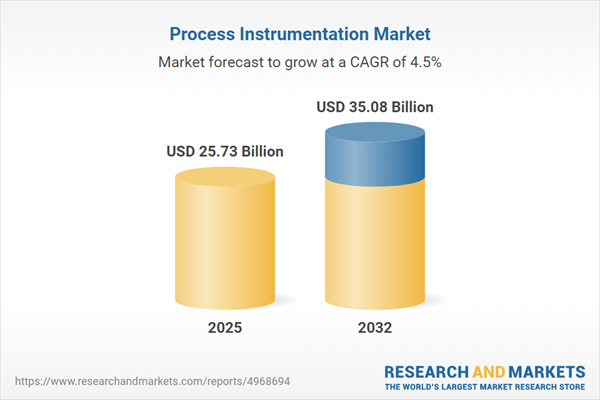Speak directly to the analyst to clarify any post sales queries you may have.
As global industries modernize, senior executives navigate the fast-evolving process instrumentation market to drive smarter plant operations, streamline compliance, and seamlessly integrate advanced technologies. Decision-makers require targeted market intelligence to inform procurement strategies and optimize long-term investments within dynamic industrial environments.
Market Snapshot: Global Process Instrumentation Market Overview
The global process instrumentation market is projected to reach USD 24.59 billion in 2024 and USD 25.73 billion by 2025, sustaining a compound annual growth rate of 4.53%. This growth is propelled by consistent capital investments in critical sectors such as chemicals, power generation, water management, and food and beverage. Rising regulatory complexity and the demand for operational excellence motivate organizations to seek advanced instrumentation solutions promoting reliability and adaptability. Senior executives prioritize assets that support steady performance, simplify compliance management, and maintain readiness for shifting industry standards.
Scope & Segmentation of the Process Instrumentation Market
This report provides a structured analysis empowering senior leaders to make informed investment and deployment decisions in the process instrumentation market. Each market segment is designed to address evolving operational needs, regulatory factors, and technology integration scenarios worldwide:
- Instrument Types: Core devices include analytical tools (pH meters, gas analyzers, conductivity meters, spectrophotometers) and process control equipment (flow, level, pressure, and temperature monitors, valves, positioners). These components are critical in ensuring precise measurement, consistent operations, and adherence to regulations within complex industrial settings.
- Mounting Types: Options such as clamp-on, immersion, inline, and insertion simplify both integration with existing assets and deployment in new facilities. Flexibility in installation enables organizations to optimize timelines and adapt quickly to changing operational and infrastructure demands.
- Technologies: Industry adoption of IIoT, wireless networks, and self-diagnostic functionalities is increasing. These technologies support real-time data transparency, predictive equipment management, and continuous process improvement for scalable enterprise operations.
- End Use Industries: Key market users span agrochemicals, specialty chemicals, oil and gas, food and beverage, pharmaceuticals, metals and mining, power generation, and water treatment. Each industry leverages process instrumentation to sustain operational safety, elevate compliance standards, and achieve ongoing performance gains.
- Geographies: The market extends across North America, Latin America, EMEA, and Asia-Pacific. Regional regulatory frameworks, technological maturity, and competitive dynamics require tailored solutions to capture growth opportunities and adherence to local standards.
- Leading Companies: Providers including Emerson Electric Co., ABB Ltd, Siemens AG, Schneider Electric SE, Yokogawa Electric Corporation, Honeywell International Inc., Endress+Hauser, Danaher Corporation, Rockwell Automation Inc., and Azbil Corporation present versatile portfolios for sector-specific demands and scalable models.
Key Takeaways for Senior Decision-Makers
- Real-time implementation of process instrumentation drives better operational visibility and enables prompt responses to process disruptions or system inefficiencies.
- Digital and wireless instrumentation solutions promote coordinated monitoring across distributed facilities and strengthen data availability, even in remote environments.
- Deployment of advanced self-diagnostic features in instrumentation supports predictive maintenance, which lowers downtime risk and enhances output continuity.
- Centralized, cloud-based asset management streamlines compliance tracking and offers comprehensive oversight over multi-site operations and reporting requirements.
- Building a diverse supplier network improves procurement agility and supports adaptability to supply chain changes, reinforcing operational reliability and flexibility.
- Focused workforce upskilling on complex instrumentation technologies streamlines compliance and increases the success rate for technology adoption across industrial sites.
Tariff Impact: Navigating Changing Cost Structures
Expected shifts in US tariffs for 2025 compel organizations to reconsider process instrumentation sourcing. A greater emphasis on regional suppliers and improved logistics mitigates cross-border uncertainties. Choosing modular and locally produced products gives executives greater flexibility and helps sustain operations in fluctuating trade conditions.
Methodology & Data Sources
This report utilizes primary insights from executive interviews, targeted industry surveys, and thorough evaluation of regulatory and technology trends. Triangulation of diverse data sources ensures findings are actionable for procurement and process optimization.
Why This Report Matters: Strategic Value for Process Instrumentation
- Enables leaders to spot emerging opportunities, forecast risks, and direct investments in line with strategic goals for compliance and efficiency.
- Offers clear recommendations for technology selection, supplier engagement, and workforce training to help retain market advantage and operational flexibility.
- Guides precise capital allocation and supports innovation for organizations navigating regulated industries and varied global markets.
Conclusion
Comprehensive insight into the process instrumentation market equips organizations to confidently address compliance challenges and achieve operational excellence through ongoing industry change.
Additional Product Information:
- Purchase of this report includes 1 year online access with quarterly updates.
- This report can be updated on request. Please contact our Customer Experience team using the Ask a Question widget on our website.
Table of Contents
3. Executive Summary
4. Market Overview
7. Cumulative Impact of Artificial Intelligence 2025
Companies Mentioned
The companies profiled in this Process Instrumentation market report include:- Emerson Electric Co.
- ABB Ltd
- Siemens AG
- Schneider Electric SE
- Yokogawa Electric Corporation
- Honeywell International Inc.
- Endress+Hauser Group Services AG
- Danaher Corporation
- Rockwell Automation, Inc.
- Azbil Corporation
Table Information
| Report Attribute | Details |
|---|---|
| No. of Pages | 193 |
| Published | November 2025 |
| Forecast Period | 2025 - 2032 |
| Estimated Market Value ( USD | $ 25.73 Billion |
| Forecasted Market Value ( USD | $ 35.08 Billion |
| Compound Annual Growth Rate | 4.5% |
| Regions Covered | Global |
| No. of Companies Mentioned | 11 |









